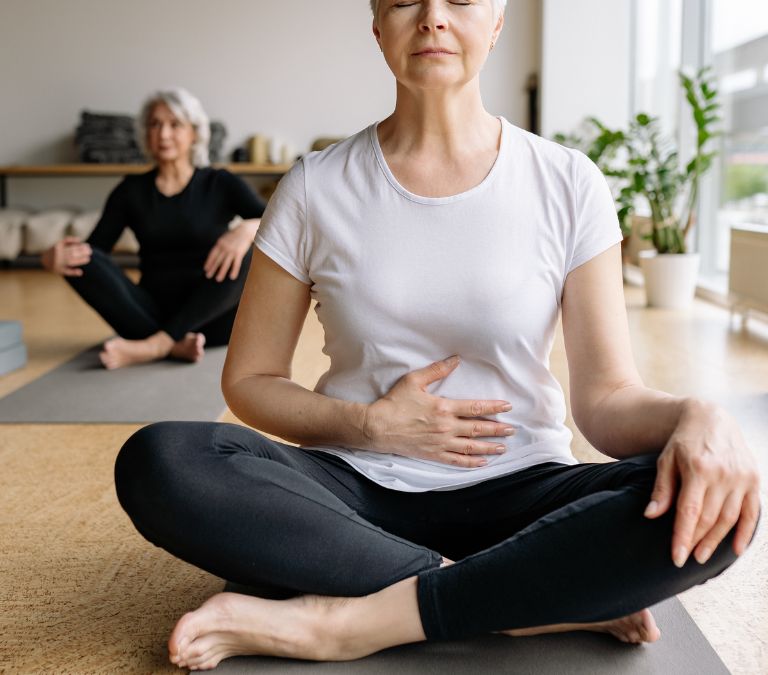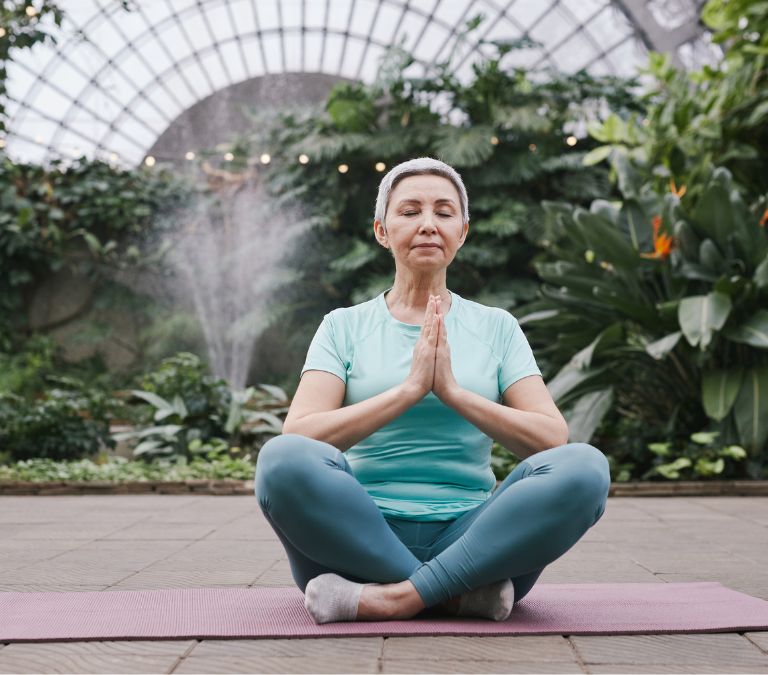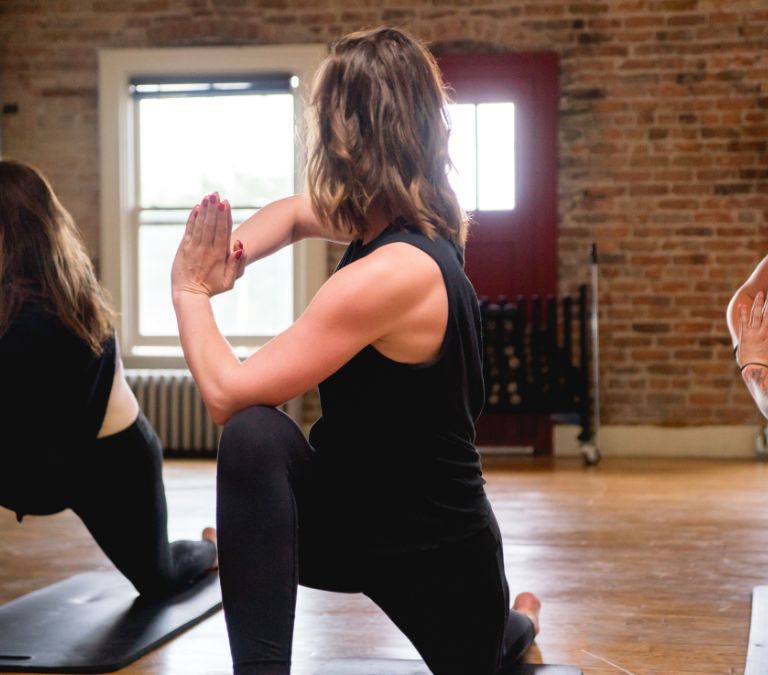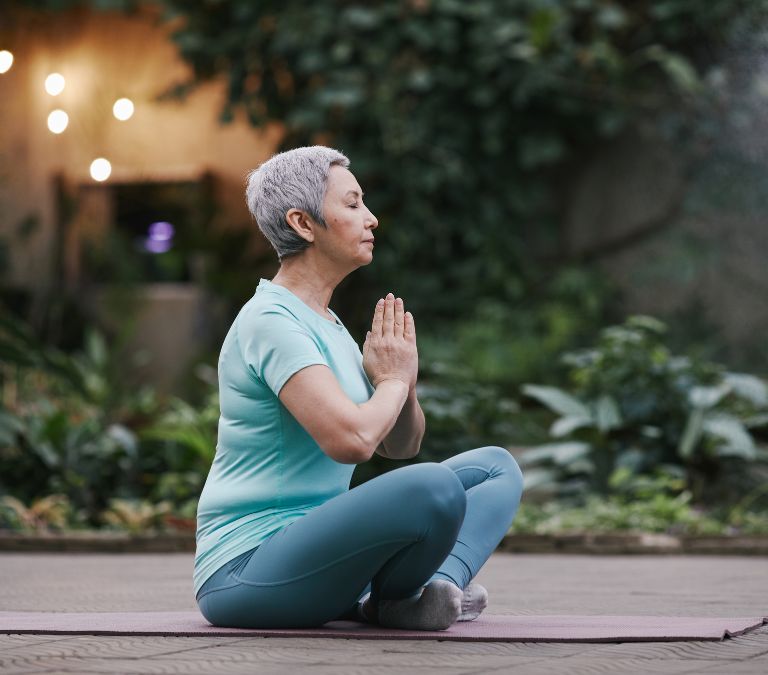Yoga is as much an exercise of the mind as it is of the body. It involves several types of postures and styles known as yoga asanas. These exercises also include special methods of breathing, relieving stress, and meditation. All these are geared towards improving the physical and mental well-being of the yogi. In this article, we will discuss about yoga for menopause and learn about the different types of yoga you can try out for menopause. Happy reading..
Some historians have traced the origin of yoga to India. The ancient people of that country were said to promote the quality of their mental and physical health by doing such exercises in their daily routine.
There are different types of yoga and special areas of the practice. All of these different types and disciplines have their peculiar benefits.
The benefits of yoga are almost inexhaustible. From physical fitness to mental stability and alertness, there is nearly no end to the gains of practicing yoga. Every day, new research and claims point to more practice advantages. It is because of the health benefits of yoga that a lot of women have taken to it.
Experts have pointed to the excellent results of practicing yoga by women of various ages, especially menopausal women. Many menopausal women have testified to the soothing effects of yoga and its great ability to relieve some menopausal symptoms.
We shall x-ray these issues in this article:
- the origin of yoga,
- various yoga disciplines such as yin yoga,
- myths and beliefs surrounding yoga and
- the merits of practicing yin yoga, especially for menopausal women
What Does Yoga Mean?
In general, yoga is an age-long practice that has to do with physical posture styles, usually for the body, and exercises involving meditation, focus, and intense breathing.
Frequent yoga exercises have been said to enhance resilience, composure, pliancy, and general wellness.
Today, many people around the globe engage in different exercise routines known as yoga.
How did Yoga Begin?

It was in a compilation of old writings known as Rig Veda that yoga was first referred to. The word’s origin is traced to the old Indian Sanskrit word ‘yuj,’ meaning ‘union.’ This word has also been translated to mean ‘to join.’
Yoga practice is believed to have begun in northern India more than 5,000 years ago.
Monks in India broadcast what they knew about yoga all over the Western countries in the latter part of the 19th century. In the late 20th century, Western countries popularized what we have today.
What is the Ideology Behind Yoga?
Yoga entails a union of the three main concepts that make up a person. These are spirit, soul or mind, and the body.
Branches of Yoga
There are six various arms of yoga. Every one of these arms or branches constitutes different purposes and features. These branches include:
Hatha yoga: this branch of yoga is a compilation of yoga’s physical and mental aspects. Its main objective is to stimulate the mind of the yogi as well as their body.
Raja yoga: is the branch of yoga that is heavy on meditation and total obedience to a set of laid down regulations referred to as the eight arms of yoga.
Bhakti yoga: this branch looks to champion devotion as a means of conveying feelings and encouraging acceptance and endurance.
Karma yoga: the purpose of this branch is to actualize a tomorrow that is devoid of evil and egocentrism.
Through diligent studies, Jnana yoga explores wisdom, the scholarly lifestyle, and the mind’s development.
Tantra yoga: this branch aims at relationships. It is the means to the finalization of relationships and everything in between.
Yoga and Chakras: chakra translates to spinning wheel. Chakras are believed to be the meeting place of strength, imagination, emotions, and the human body. Teachers of yoga state that it (that is, chakras) is a decider of how a person views life through various feelings and physical reactions, all in a spinning wheel.
A blockage of the spinning wheel by different energies results in an imbalance of the physical and mental aspects of a person’s life. It is evident in outward feelings such as fatigue, restlessness, and constipation.
The positions or poses taken in hatha yoga practice are called Asanas. It is these various poses that yogis practice in a bid to free up clogged energy in the chakra wheel and cause their chakra to balance.
Chakras are of 7 varieties, and each has a particular purpose of interest. They include:
- Sahasrara: this is known as the crown chakra. It is situated at the top of the head. It stands for the relationship with the spiritual realm.
- Ajna: this is referred to as the third eye chakra. It seems to be because of its position in-between the eyebrows just above the nose. It may also be because of its relationship with the ability for quick spotting and understanding.
- Vishudda: is the name for the throat chakra. It is related to oral communication and the ability to withstand external forces.
- Anahata: this is located in the middle of the chest. It is the heart chakra. It controls relationships, including personal and impersonal relations. Inconsistencies in this chakra will rub off on a person’s physical well-being, such as the control of their organs, balance of hormones, and good working of their tissues and other parts of their body.
- Manipura: this chakra is related to a person’s attributes, such as self-confidence, composure, and continence. It is situated around the stomach. Thus, it is known as the chakra of the solar plexus.
- Svadhishthana: is a connector of various qualities such as pleasure, health, and strength. It is located just under the belly button and is known as the sacral chakra.
- Muladhara: the bottom chakra. It is the chakra at the lower end of the human spine. It is the connection between a person’s body and mind with the earth. It is believed to keep such a person grounded. Certain nerves, such as the sciatic nerves, are influenced in this way. Also, the parasympathetic nerves are affected.
Types of Yoga

Today, yoga involves physical exercises, deep breathing, strength building, and skill. It is believed to improve the physical and mental health of people who practice it. The yoga style choice should follow the yogi’s strength level and what they hope to achieve from the exercises. Some of the styles include:
- Iyengar yoga: This style uses extra enhancers such as blankets, chairs, blocks, and so on to achieve the desired accurate form in any pose.
- Hatha yoga: refers to the general name for the different types of yoga practiced for learning the basics of physical postures. It is a preparatory style for people looking to go into more advanced yoga styles.
- Ashtanga yoga: the ashtanga yoga style utilizes age-long yoga practices. It became well known in the early ’70s.
- Kundalini yoga: if you have so much built-up stress and energy, you should try this yoga style. This yoga style focuses on the mind with the use of meditation. It comprises singing and chanting interspersed with a few asanas.
- Bikram yoga: also referred to as hot yoga, is the style of yoga in an artificially hot environment. It comprises at least two breathing activities and about 26 sustained postures.
- Kripalu yoga: This style seeks to cause the yogi to find strength from the inside. The yogi learns to find their level by monitoring and mastering their bodies. Kripalu yoga classes comprise activities like breathing, stretching, simplified sustained postures, and rest.
- Power yoga: as the name suggests, this type of yoga requires a lot of physical activity. It was developed at the end of the 20th century and originated in the ashtanga method.
- Viniyoga: is more interested in the form. It also makes use of adaptation and breathing alterations.
- Prenatal yoga: pregnant women are the target of this type of yoga. It is helpful both during and after pregnancy. During pregnancy, it is practiced to ensure the mother’s health and prepare her body to carry the pregnancy to term and deliver without much distress. After pregnancy, it works to get the new mother to regain her shape before the pregnancy and childbirth.
- Restorative yoga: This style involves simple sustained postures that do not require effort. It features lots of resting done in these poses and is enhanced by extra items such as bolsters, blankets, etc.
- Yin yoga: this style involves sustaining postures for hours. The aim is to influence hard-to-reach areas of the body, such as deep tissues, joints, and bones. It is believed to be of great help for menopausal women.
What is Yin Yoga all About?
The popular yoga style which everyone seems to be into is referred to as the ‘yang’ yoga style. Active and strength-tasking exercise routines characterize them.
On the other hand, another style of yoga is completely different from the yang one. It is known as yin yoga. Though not as exerting as the mainstream yang yoga, yin yoga is still very much beneficial to yogis who practice it, especially menopausal women, some of whom have testified to the soothing power of yogic practices.
Yang yoga has the muscles as its main focus in the body, but yin yoga is interested in the deep connective tissues such as the connective ligaments, joints, fascia, and bones. Yin yoga asanas are also slow-paced compared to the fast-paced exercises of the yang variety.
It focuses on meditation and seeks to influence the yogi to find strength within themselves and the feelings they get.
Yin yoga requires that you sustain your posture for very long periods. It helps to expand those connective tissues you rarely use and, simultaneously, train yourself to sit still and breathe comfortably despite the slight distress to your body.
The beginning of yin yoga practice is traceable to age-long principles of Chinese and Taoist origins, which are of the view that there exist in our bodies lines of communication of Qi (energy). They posit that by engaging in yogic exercises such as stretching and holding certain poses, the yogi removed all hindrances, thus making way for the flow of the energy within.
Yin yoga exercises have been compared to acupuncture treatment as it is believed to give the same effect on the body as the former: causing the body to revive the flow of energy (Qi).
The focus is not on quick movement from one pose to another. Rather, it is to sustain those poses for as long as possible. It affects the deeper and seldom stretched tissues such as joints of the hips, spine, and so on.
How Good is Yin Yoga?
The benefits of practicing yin yoga are limitless. It is not just the physical advantages that you stand to enjoy. There are also a lot of mental health benefits that all add up for the proper growth and development of the yogi.
Expansion of the Connective Tissues
Some of our connective tissues have slackened due to inactivity and are wrapped loosely around the bones and muscles. It is the reason for the frequent aches and rigidity. Yin yoga helps stretch these tissues so that they elongate a little to make room for easy movement of the bones and muscles.
Improved Pliancy
When your connective tissues get the much-needed stretch and expansion from yin yoga exercises, you begin to experience easier movement, especially around the joints. No more stiffness. Connective tissues such as the fascia need long stretching periods to improve their pliancy. It is easily achievable with the long sustenance periods of yin yoga asanas.
Better Oxygen and Blood Circulation
Yin yoga is not all about sustained postures. Deep breathing exercises enhance the inflow of oxygen onto the body and, in turn, improve blood circulation around the body.
Eases off Stress
Yin yoga has been claimed to be a form of relaxation and relief from stress and restlessness. Its calming qualities have also been a great remedy for high blood pressure. It is also uplifting, thus preventing the dangers of depression.
How Do You Practice Yin Yoga?
One of the great perks of yin yoga is that it can be practiced practically anywhere and at any period of the day or night.
The essential thing to do is to sustain a given posture for a prolonged period, at least five minutes.
Fortunately, the poses in this style of yoga are not complicated, so you do not need extensive training on putting yourself in the postures. They are usually done while seated or lying against a surface. It is to provide proper relaxation for the muscles. Some poses include the butterfly pose, the frog pose, and the seated forward fold.
It will help if you find a good position to be as still as possible. It will help you settle into the realm of comfortable discomfort known in yogic parlance. Your ligaments and tissues will get the needed stretch in this state of body and mind. Whatever you do, never allow yourself to suffer pain before you get up from the pose.
The Essence of Breathing During Yin Yoga
Breathing, especially deep breathing, is very important in yin yoga exercises. It is an avenue to avert your mind, especially during the long period of sustaining the poses.
The deep breathing exercises require you to breathe in with your diaphragm, thus stretching your belly muscles and ribs. You can feel your navel move towards your spine when you breathe. Ensure that you breathe out longer than you breathe in.
Benefits of Yin Yoga for Menopause

An increasing number of women have attested to yoga asanas, especially yin yoga exercises, in alleviating menopausal symptoms such as hot flashes, depression, sleeplessness, pains, and so on.
These poses and exercises are cheaper and safer for managing menopausal symptoms than medical and non-medical methods.
Menopause is a period of a woman’s reproductive life when she no longer sees her menses. This period is marked by sudden changes in the woman’s body occasioned by the imbalance in hormone levels. It can have certain side effects such as indigestion, anxiety, sleeplessness, and pains, to mention but a few.
While the physical effects of menopause, such as bone thinning and muscle loss, can be catered for by the physical yin yoga poses, the emotional symptoms such as depression and anxiety are also addressed by a combination of the breathing exercises and the various sustained poses.
There are some yin yoga poses you can incorporate into your exercise routine. Be sure to discontinue them if you experience pain or excessive discomfort.
The Reclining Bound Angle
This pose effectively works the muscles of the pelvis and cools the whole body; thus, it reduces menopausal symptoms such as hot flashes and helps you relax. It also improves hormone level balance.
It entails laying your back on the yoga mat with your knees bent and your feet flat on the floor. Then, open your legs wide apart, so your knees are on the opposite sides. Bring the edges of your feet together. Maintain this posture for at least 2 minutes. Be sure to use blankets or yoga blocks for support if you experience difficulties.
Legs Up Pose
It is an inversion pose with support. It is a pose that cools your body by ensuring that blood circulates well around your body. It helps with the swelling that is experienced during menopause. Its cooling effect is also great for managing hot flashes and feelings of anxiety.
It is also a simple pose to take. All you have to do is lay on your mat as a fetus does in the womb. Then roll till you are on your back and put your legs up in the air or place them on the wall for support and take deep breaths. Hold this pose for 60 to 120 seconds.
Wide Seat Angle
You should try this pose if you are experiencing menopausal symptoms like lower back or muscle pain. It improves blood flow around the body and massages the uterus.
Hold your hips on a yoga prop such as a blanket or block to strike this pose. Stretch your legs forward, then stretch them in the opposite direction: right leg to the right and left to the right. Sit upright and bend slowly until your hands reach the yoga mat. Hold this position for 2 to 5 minutes, and discontinue if you feel pain. Be sure to use more yoga props if you are not pliant enough.
Dog Facing Down Pose
This pose works mainly for your mind. It improves oxygen supply to the brain, thus relieving anxiety and enhancing memory. It is also a great way to manage bone thinning.
This pose involves the following:
- Get down on your hands and knees like the position of a dog. Your hands and thighs should be parallel to each other.
- Move back with your hips and bend forward to get into the upside-down V position.
- Maintain this position with your hips pointing upwards and your chest moving towards your chest.
Conclusion
Yoga is a great way of relieving menopausal symptoms that beset many women. Not only does it help manage the physical symptoms, but it also provides assistance for anxiety and depression, which many women experience during this period.
Meditation, an integral part of yoga, improves alertness and calms the mind.
There are simple yoga styles like yin yoga that you can practice to help soothe menopausal symptoms. The good thing is that you do not need to get any serious training to master these poses.
Be sure to keep to the cooling poses as some poses, especially those that require you to grip or hold fast to something, may worsen menopausal symptoms such as hot flashes. Take deep breaths while on it, and be sure to seek out a professional yoga instructor for advice if you experience any difficulties.







